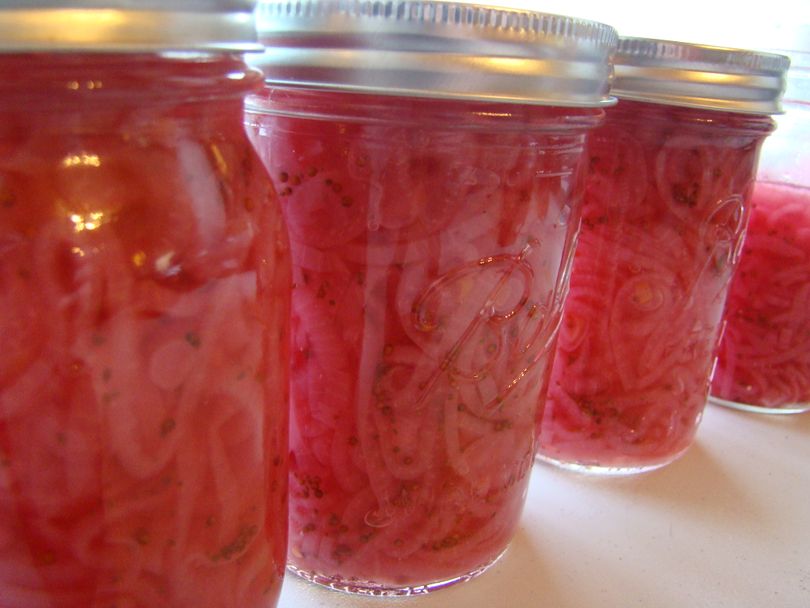Canning: Pickled Red Onion

After making egg dyes with onionskins, I was left with six skinless red onions—that’s a lot of onion if you’re counting. Naturally, the thing to do with nearly four pounds of onions is make a pickle. I did store the onions in the veggie drawer for a few weeks before I found the time to pull out the canning pot, but they were no worse for wear.
While experimenting with pickles has been fun (and delicious), there is always a danger than what you pickle won’t be as delicious as the idea of the pickle. Unlike jam, pickled fruits and vegetables need time to sit and absorb the pickling liquid, so tasting as you go isn’t practical and both flavor and texture change as the pickles develop after processing. For instance, I loved the idea of the pickled green tomatoes I made last fall, but I don’t love the pickle itself. Now I have about 10 jars of dill-flavored mush in my pantry and am going to have to add the contents to the compost, the waste of which makes me cringe. (Green tomato salsa, however, is wonderful, so this year’s unripe tomatoes will all be made into salsa). Despite the danger of not loving the product, I still love experimenting (safely, of course).
In our house, pickled red onion rings have been canned, tested, and shot to the top of our favorite condiment list. They are delicious and versatile. We opened a jar immediately after testing the leftover bit of onion that didn’t fit into our jars. I also like that onions are both inexpensive and can be found (or grown) locally.
Before starting my batch, I pulled my canning books off of the shelf and did some reading. While onions are a low-acid root, pickling with the right vinegar dilution makes them safe for water-bath canning. I developed my own recipe based on reading about a dozen from various sources. Here’s what I came up with:
Pickled Red Onion
approx. 3 lbs. red onions
2 cups cider vinegar (5% acidity)
½ cup water
1 tablespoon pickling salt
2 tablespoon sugar
1 tablespoon brown mustard seed
1 teaspoon celery seed
Fill your canning pot with your jars and cold water and bring to a boil. When it has reached a boil, turn the temperature down and simmer for 10 minutes or until you’re ready to fill the jars. Place the lids in a small saucepan and bring to a low simmer to soften the seal.
Slice onions as thinly as possible. I used a mandolin for this, setting the slice to 1/8”. Bring a large pot of water to a boil and add the sliced onion. Cook for about 5 minutes, drain, and set aside. (This process takes some of the bite out of the raw onion and will allow the onion to better absorb the brine).
Using the onion pot, combine the brine ingredients. When the salt and sugar are dissolved, add the onions, stir to combine, and remove from heat.
Remove the jars from the canning pot. Fill with the onions and brine, leaving ½” headspace. Use a chopstick or end of a wooden spoon to bubble the jars. You want to remove as many air bubbles as possible to avoid siphoning during processing. These buggers trap air like crazy, so take your time with this step.
Wipe rims, apply lids, and screw on bands.
Process in a boiling water canner for 10 minutes (15 minutes for Spokane).
When the time is up, remove the jars and allow them to cool on a towel-lined countertop until they are completely cool. Check seals and store in a cool, dark place. Let cure for at least 48 hours (if you can wait that long) prior to opening jars.
We have already enjoyed pickled red onion rings on roast beef and tuna sandwhiches, with spreadible cheese on crackers, on pizza, in green salad, and straight out of the jar.
